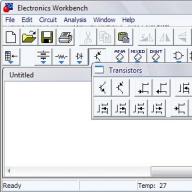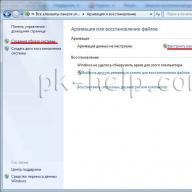Simple and reliable software package for creating, editing, analyzing and calculating antennas using the method of moments.
The MMANA-GAL calculations are based on the Maxwellian system of equations, and the computing base is the modernized MININEC3. The program works with any types of antennas presented as sets of thin wires. Antennas can be easily drawn and corrected either by specifying numerical values or in a graphics window that has a volumetric representation. The program can link together up to four different model files, creating entire antenna complexes. The calculation will take into account the loads and wires of all antennas of the composite system. Any change made after calculating the model can be rolled back. The number of rollback operations is limited only by the size of the hard disk.
The calculation is carried out at any frequency. Before it starts, the project is automatically checked for errors. If any are found, a description appears in the information window, and the cursor shows the problem wire. After fixing the error, the program moves on to the next flaw. The calculation results are depicted by directional diagrams (including three-dimensional ones), as well as many different graphs-dependences.
The optimization function automatically adjusts the antennas according to the specified parameters. Also in MMANA-GAL there are a number of additional calculations for coils, matching devices, long lines. The main disadvantage of the program is that it ignores ground losses when calculating the input impedance and near-field data. The errors will be the greater, the more the parameters of the earth differ from the ideal values.
The results of the work can be presented in the form of a number of files with different extensions: * .maa (antenna description), * .mab (calculation results), * .mao (optimization file), * .csv (current table), * .csv ( near-field table), * .csv (gain table for different angles).

The software package is presented in two versions: free basic MMANA-GAL basic and professional MMANA-GAL pro. MMANA-GAL basic is geared towards amateur radio needs. Unlike the paid package, it significantly reduces the speed of calculations and the number of model elements (segments, wires, sources, loads), and lacks a number of features such as auto-checking or combining antennas. Working files of the professional version can be opened by the basic one only if the number of elements of the models lies within the limits allowed for the MMANA-GAL basic.
Three people took part in different stages of development of MMANA-GAL. Makoto Mori is the author of the idea and creator of the Japanese version of the program called MMANA ( M acoto M ori AN tenna A nalyzer). In 2001, he gave the source code to Igor Goncharenko (http://dl2kq.de), who translated the software into Russian and expanded the model library. In 2004 he was joined by Alexander Shevelev (http://dl1pbd.de) who reworked and optimized the code for Builder C ++ 6.0, accelerated the calculations of the program, added many useful functions and windows. In May 2006, the program was released again, receiving the name MMANA-GAL (GAL as an abbreviation for Igor G oncharenko and AL Alexander Sheveleva).
In 2011, the latest version of MMANA-GAL basic 3.0 was released. The authors are currently working on a new project called GAL-ANA, in addition to this, they continue to support MMANA-GAL pro.
Since MMANA-GAL was created by the efforts of domestic enthusiasts, the program has a Russian-language interface. In addition, in the settings it is possible to change the language of inscriptions and messages to a number of other languages.

This program works only in the operating system Windows 2000, XP, Vista and 7. Supports 32- and 64-bit systems. The minimum RAM size is 1 GB. On a 32-bit operating system, the maximum number of segments for calculation reaches 15000 pieces, on a 64-bit operating system - 32000.
A good antenna is the main factor for good reception! Whether it's a radio station, cell phone, receiver, car radio or TV. Correctly calculating the size of the antenna is a rather complicated process. We need drawings, dimensions, formulas ...
But with the help of the free MMANA program, which is not inferior, and in some ways superior to their professional counterparts, you can simulate what kind of antenna we need, see its directional pattern, and also you can see how it will work as an antenna and get all its characteristics. Moreover, you can investigate the antenna by changing its parameters, optimize it for specific conditions and requirements. Indeed, on a real antenna, it is either very difficult to measure many parameters, or almost impossible. The study of the computer model allows you to get all imaginable characteristics of the antenna.
Using the MMANA program, you can:
- Consider many different antenna types.
- Create and edit antenna descriptions both by specifying coordinates and using the mouse.
- Calculate antenna radiation patterns (DP).
- Compare simulation results for several different antennas.
- Transform various types of antennas (“wave channel” into “squares”, etc.
- Calculate and edit the description of each antenna wire, consisting of several, different diameters.
- Use the convenient menu for creating multi-storey antennas - stacks, and as a stack element you can use any existing or created antenna.
- Automatically calculate several types of matching devices (SU) by turning them on and off when plotting.
- Calculate coils, circuits, inductances and capacitances made from pieces of coaxial cable.

System requirements
- OS-Win95 or higher
- Processor 486DX25 and above
- RAM not less than 8 MB
- monitor resolution 800 x 600.
Installing MANNA software
To install, simply unzip the mmanarus.zip file into the MMANA directory. You need to create it yourself using Windows tools on your hard disk.
The program does not create a shortcut on the desktop, but if you wish, you can do it yourself using the standard Windows procedure.
The MMANA program will help you save a lot of your time, bring useful and interesting information, help you develop your own antennas for your materials, terrain and equipment.
Program creators

- MMANA-GAL is the most popular program for calculating antennas. Any antenna that can be thought of as an arbitrary set of thin wires. The calculation is performed by the method of moments. Free. For trained radio amateurs.
- 4NEC2 is another popular antenna simulator. Also free, the interface is in English. Unlike MMANA, which is popular with us, thanks to I. Goncharenko, this program is less known. Western radio amateurs have a completely opposite picture, 4nec2 is the most popular free antenna modeler there.

- Service programs for tuning the antenna to the direction of the base station for 3G UMTS, CDMA EVDO modems, as well as for setting up Wi-Fi equipment
- For owners of smartphones and tablets on the Android operating system in the store Google play Cantennator. Kharchenko antenna, canned, spiral antennas, as well as the Triple Square antenna, WiFi gun, Double BiQuad, collinear antenna
 If for some reason you do not have access to application stores, you can download the installation apk-file of the latest version of the application from this link. Those who have the latest version does not work and owners of devices with Android 3.0 and below can download the previous 9th version of the application. Don't forget to enable permission to install applications from "unknown sources".
If for some reason you do not have access to application stores, you can download the installation apk-file of the latest version of the application from this link. Those who have the latest version does not work and owners of devices with Android 3.0 and below can download the previous 9th version of the application. Don't forget to enable permission to install applications from "unknown sources". - Play free app available LPDA designer. The application allows you to calculate the log-periodic antenna. You can download it to your mobile device by clicking on the button below. Don't forget to rate the app ...

- For owners of smartphones and tablets on the Android operating system in the Google store Play free app available Dipole Antenna Calculator... The application allows you to calculate linear and split dipole, GP antenna, J-antenna, Butterfly antenna. You can download it to your mobile device by clicking on the button below. Don't forget to rate the app ...

- Antenna Books
- Carl Rothammel's two-volume "Antennas" (11th edition) is one of the most famous books on antenna fundamentals and practical designs. The first volume contains the theoretical foundations necessary for the design and operation of amateur radio antennas, the issues of their balancing and matching. The second volume of this book contains descriptions of VHF antennas of the meter and decimeter bands of radio amateur bands, antennas used for receiving television, mobile antennas, antenna amplifiers.
- Kharchenko K.P. "VHF antennas" 1969 - principles of operation, methods of power supply and practical designs of vibrator and zigzag antennas. Methods and principles of matching and balancing. Antennas' handbook.
- Benkovsky 3., Lipinsky E. Amateur antennas of short and ultrashort waves (1983) Translated from Polish. A wide range of issues on the theory of antennas, transmission lines, and radio wave propagation are considered. Practical antenna designs with detailed descriptions.
A good antenna means excellent reception! Whether it's a radio, mobile phone, receiver, car radio or TV. But it is quite difficult to correctly calculate the various parameters of the antenna, it is long and tedious. Therefore, various radio amateur programs come to our aid for calculating antennas, for example, MMANA
With the help of the program for calculating the antenna, you can simulate almost any antenna, see its radiation pattern, and you can also see how it will work as an antenna, and get all its main technical characteristics. In addition, it is possible to investigate the antenna "along and across" by changing this or that parameter, to optimize it for the conditions we need. After all, if we have already made the antenna, most of the parameters cannot be changed. Experiments with a computer model of the antenna will allow you to get all its possible characteristics.
Features of the MMANA program
Analyze a huge number of different types of antennas
Create and edit antenna parameters and descriptions
Calculate different radiation patterns
Compare simulation results of different antenna types
Transform different types
The program has an excellent convenient menu for creating multi-storey antennas, and as an element you can use any existing or created model.
Automatic calculation of several types of matching devices, the ability to turn them on and off when building graphs
Calculation of loop coils, inductance and capacitance made from pieces of different types of coaxial cable and other possibilities.
To install the utility for calculating MMANA, unzip the mmanarus.zip file into the MMANA directory. It must be created in advance on the hard disk of the computer. The program does not create a shortcut on the desktop, but you can easily create it yourself if you want.
The main advantage of the MMANA program is that, despite the enormous possibilities, it remains completely free. Plus, there are other programs in the archive for calculating antennas: Spindler's wave channel - Calculation occurs either by the TV channel number or by the operating frequency. And also the calculation of VHF antennas from 30 to 2400 MHz
APAK-EL includes two programs for calculating lines for antennas with active power supply according to A. Christman's method and calculation and optimization of matching devices on the lines. The calculation of lines can be carried out taking into account losses and there is a data library with the ability to add the necessary information. The help contains several examples of working with the utility.
ASA 1.1- Antenna System Analyzer determines the performance of your antenna system. Its modification and design is also possible.
MLOOP 3.1- for designing magnetic antennas for the frequency range from 1 to 60 MHz.
Calculation of the antenna "Spindler's wave channel"
MMANA-GAL- a program for calculating and analyzing antenna systems by the method of moments.
Satellite Antenna Alignment |
 The utility is used to calculate the angles that are required when installing a satellite dish. You can calculate the azimuth and elevation (elevation) for each satellite separately. The main difference from similar programs. the ability to calculate immediately for all satellites... And thus determine which satellites can be caught from the antenna installation site, and which ones will have to be forgotten. Do not forget that the calculation is purely theoretical, according to the formulas, and in real conditions, when installing the antenna, you need to take into account many more factors, such as various obstacles (buildings, trees), terrain, height above sea level, direction of transponders
The utility is used to calculate the angles that are required when installing a satellite dish. You can calculate the azimuth and elevation (elevation) for each satellite separately. The main difference from similar programs. the ability to calculate immediately for all satellites... And thus determine which satellites can be caught from the antenna installation site, and which ones will have to be forgotten. Do not forget that the calculation is purely theoretical, according to the formulas, and in real conditions, when installing the antenna, you need to take into account many more factors, such as various obstacles (buildings, trees), terrain, height above sea level, direction of transponders
polarization, etc. But nevertheless, this program will allow you to assess the state of affairs quite accurately.
The resulting calculation can be saved to a text file, copied to the Windows clipboard, or directly output to a printer. Export to MS Excel and MS Word is available. It is possible to memorize a list of places for which the calculation was made. Subsequently, you will no longer need to enter the coordinates of these places again.




